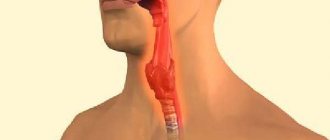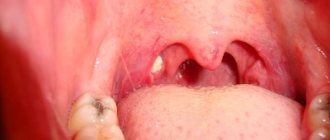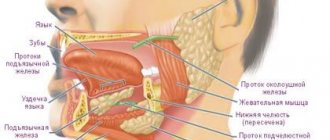Otolaryngologist for adults and children
Manevich
Igor Semenovich
Experience 27 years
Otorhinolaryngologist of the highest category, member of the European Rhinologic Society
Make an appointment
With inflammation of the laryngeal mucosa, laryngitis and concomitant diseases with sputum production often develop, so many patients wonder what it is, what are the causes, signs and symptoms of the disease, how to diagnose and how to treat to avoid complications. The occurrence of laryngitis can be triggered by viral, bacterial or fungal pathogens. The disease is of infectious origin through airborne droplets, contact, or to the fetus in the womb during pregnancy. Forms of laryngitis in adults caused by allergens or occupational activities are not contagious.
Introductory information
Laryngitis is an inflammatory process of the larynx with sputum production, which is promoted by various pathogens. Both adults and children of different age groups are susceptible to the occurrence of a pathological condition, especially children with weakened immunity and concomitant diseases. In most cases, the disease proceeds without significant complications; the process of complete recovery occurs in 7-10 days.
The acute form can develop due to respiratory infections, acute respiratory viral infections, influenza, and adenovirus infection. It can also occur as a concomitant factor in measles, diphtheria, tuberculosis and whooping cough.
Classification of pathologies of the upper respiratory tract:
- acute laryngitis manifests itself as a separate or concomitant pathology, the main signs are the primary manifestation and the effectiveness of therapy, after which after two weeks there are no consequences or complications for the body;
- the chronic form can occur due to untreated pathology and inflammation in the larynx and upper respiratory tract. It is characterized by the production of sputum. The key factors of the pathological condition are smoking, which increases the volume of sputum, and the ligaments being under constant strain.
In the absence of timely treatment of laryngitis in adults, the pathological condition turns into a chronic form and contributes to certain complications. Mostly they are associated with respiratory problems, since the larynx is an organ of the respiratory system. The main complications include:
- bronchitis;
- loss of sonority and beauty of the voice;
- false croup - mainly occurs in children. Inflammation contributes to whistling and asthma attacks;
- airway obstruction;
- mediastinitis - inflammation quickly occurs in the space between parts of the adult’s larynx, which often ends in death;
- laryngeal paresis – dangerous due to respiratory dysfunction;
- phlegmon of the neck is an acute purulent inflammation that affects the upper respiratory tract. It develops in the absence of therapeutic measures and is an indication for surgical intervention.
There are three forms of chronic pharyngitis:
1. Catarrhal.
In this case, inflammation of the pharyngeal mucosa does not in any way change the structure of its tissues. Usually this form develops in the initial stages of chronic pharyngitis.
3. Atrophic.
With this disorder, the mucous membrane of the pharynx becomes thinner and thinner over time, and its secretory function suffers. This form of pharyngitis is especially dangerous for the development of various infectious complications, since it is now much easier for pathogenic microorganisms to attach to epithelial cells that are not protected by mucus. Atrophic pharyngitis is characteristic primarily of smokers.
3. Hypertrophic.
Here, inflammation primarily affects the lymphoid tissue on the back wall of the pharynx, causing it to become red, overgrown, and swollen. There may also be an increase in the size of the tonsils and lymph nodes located in the neck.
Symptoms and causes
In order to clearly understand the causes of laryngitis in adults and children, it is necessary to determine the pathologies that occur in the larynx and upper respiratory tract during the disease process. The muscles and cartilages of the larynx are covered by the vocal cords, which, when closed correctly, move smoothly and allow air to pass through, which contributes to the production of sound.
Laryngitis is an inflammation of the mucous membrane of the throat - the vocal cords. As a result of edema, the mechanism of ligament closure is disrupted, the lumen narrows, and the amount of sputum increases, which can lead to suffocation and other complications.
Let's look at the typical causes of laryngitis:
- allergic reactions that appear as a result of various irritants and are characterized by regularity in the presence of irritating factors;
- infectious agents;
- prolonged inhalation of frosty or hot air;
- the causes may be injuries to the throat and related organs in adults;
- a common cause is regular overstrain of the vocal cords;
- with laryngitis, further development of the pathology is facilitated by inhalation of polluted air, as a result of which sputum production increases.
The problem appears in the respiratory tract due to various external and internal factors. To determine treatment tactics and select appropriate medications to eliminate the causes of laryngitis, the doctor must identify clear causes and symptoms, and the patient’s complaints. Only competent elimination of characteristic causes and individual manifestations will allow choosing effective treatment methods for quick relief from the symptoms of pathology without complications and complete recovery.
The classic symptoms of inflammation are characterized by signs that can be easily identified not only by the doctor, but also by the patient himself, since such processes in the larynx have some distinctive characteristics. Main symptoms of laryngitis:
- disturbances in vocal activity are the primary signs of laryngitis. The vocal cords are characterized by being in an inflamed state, swollen, and the voice becomes hoarse. Painful sensations worsen when trying to speak loudly or scream;
- With laryngitis, narrowing of the larynx contributes to breathing problems. Therefore, this symptom of laryngitis with difficulty breathing often develops into false croup with severe complications;
- accompanying symptoms of laryngitis in adults are general poor health, loss of appetite, low-grade fever and chills;
- headache.
The main symptoms by which the diagnosis is made are signs from the first two categories, the rest are accompanying only to confirm the disease.
The key manifestations of the causes of laryngitis are a feeling of dryness in the throat, soreness and burning, tingling and other unpleasant sensations in the throat. Such conditions are also typical when the patient suffers from ARVI or influenza, but in this case they are more pronounced. The patient may also have a feeling of the presence of a foreign object in the larynx and pain. A common symptom of laryngitis is a dry cough, which turns into a wet cough with the release of a large amount of sputum. Basically, infectious causes of laryngitis lead to this course of the disease.
Laryngitis is characterized by low-grade fever and fatigue. The voice of patients with laryngitis may become hoarse, hoarse, or disappear completely. Depending on the causes of the pathology, at high temperatures and other signs of complications, it is necessary to take timely therapeutic measures aimed at comprehensively combating the pathological disease of the respiratory tract.
Symptoms of the disease
Laryngitis begins with sharp intense pain, soreness and a feeling of a “lump” in the throat. It is difficult and painful for the patient to speak, the voice becomes hoarse. Against the background of hyperemia of the larynx, difficulties with swallowing and breathing may occur. As the disease progresses, symptoms of intoxication appear - headache, fever, chills, weakness. Inflammation is accompanied by a convulsive, hysterical cough that does not bring relief, during which a large amount of sputum is released, sometimes mixed with pus.
Diagnosis of the disease: how it goes, what procedures are performed
To diagnose pathology of the upper respiratory tract, it is necessary to examine the throat by a qualified otolaryngologist, who takes an anamnesis, prescribes tests, laryngoscopy or a biopsy of the affected area of the larynx.
The pathology is diagnosed during the initial examination, then to confirm the diagnosis it is necessary to take laboratory and biochemical blood tests, and you can also do an ultrasound scan to see the presence of sputum in the larynx and upper respiratory tract. When taking blood, a bright red hue of the blood indicates insufficient coagulation and the occurrence of inflammatory processes in the body. Often, in the presence of inflammation, the pathological condition is diagnosed using a biopsy in order to select appropriate antibiotics.
If there is difficulty breathing or pain in the upper respiratory tract, the patient should be immediately checked by a qualified doctor. In the presence of minor symptoms and manifestations on the laryngeal mucosa, patients often confuse the pathology with ordinary shortness of breath or a cold. In such conditions, carrying out routine diagnostics and examination is very difficult; it is necessary to check the current state of the larynx using a modern method - laryngoscopy.
This diagnostic method is carried out using a laryngoscope and allows the doctor to deeply examine the larynx by viewing through a backlit mirror. This diagnostic method is used to identify swelling of the throat mucosa and the location of blood vessels. Basically, in adults with laryngitis, the following signs are revealed: overflow of blood vessels, and overflow of the throat mucosa with sputum, bilateral pathology in advanced cases. Laryngoscopy allows the doctor to make an unambiguous diagnosis; this condition can be cured with properly selected medications.
To determine the severity of the disease with laryngitis, examinations are prescribed using radiography or computed tomography of the larynx, endofibrolaryngotracheoscopic method. These methods are not basic and are prescribed only if there are prerequisites and indications. In some situations, differential diagnosis is necessary to exclude oncology of the upper respiratory tract and laryngeal tuberculosis.
What types of laryngitis are there?
Currently, doctors use several classifications of laryngitis simultaneously, which makes the diagnosis as detailed and informative as possible.
- By type of course: acute (lasting up to 3 weeks) and chronic laryngitis.
- According to the prevalence of the inflammatory process: limited (with damage to certain areas of the larynx) and widespread (diffuse);
- According to the nature of changes in the mucous membrane: catarrhal, atrophic, hypertrophic (or hyperplastic), the last 2 forms are characteristic only of the chronic process;
- By etiology: infectious (viral, bacterial, fungal) and non-infectious.
Doctors treating the disease
Many patients wonder which doctor treats the larynx, respiratory diseases in children and adults, and identifies the causative agent of the pathological condition. If you have a painful sensation in the throat or diseases of the upper respiratory tract, you should contact an otolaryngologist rather than a general practitioner.
A doctor who is directly involved in the diagnosis and treatment of laryngitis in adults is an otolaryngologist. To diagnose the main signs and make a diagnosis, you must contact a qualified ENT specialist in a clinic or private clinic. Experienced doctors with high qualifications and significant work experience at JSC “Medicine” (clinic of Academician Roitberg) are engaged in diagnostic procedures and treatment for adults and children of different ages. An experienced doctor treats the disease on an outpatient basis using effective medications, and in case of significant complications, prescribes hospitalization.
WHAT SYMPTOMS SHOULD YOU CONSULT AN OTOLARINGOLOGIST?
Symptoms of diseases of the ENT organs cannot be ignored. You should consult an otolaryngologist if you are concerned about the following symptoms:
- breathing complications;
- whistling when breathing;
- pain when swallowing;
- redness of the throat;
- enlarged lymph nodes under the jaw;
- hoarseness and sore throat;
- fatigue, dizziness;
- cough;
- pain in the ear when swallowing;
- sensation of a foreign body in the larynx;
- hemoptysis;
- pain in the throat area.
Treatment methods
Modern methods of treating laryngitis depend on the symptoms, causes and indications; they are selected only after a thorough diagnosis and determination of the causative agent of the laryngeal disease. Since the course of the pathology occurs in different ways, the forms differ in course and symptoms, laryngitis in adults in each form has different treatment. Therefore, we will consider the key principles of treatment, as well as what method is recommended to treat the disease in one form or another. Therapy is mainly carried out on an outpatient basis; in case of a complex and advanced form of the disease, the patient undergoes procedures in the hospital.
Diagnosis of laryngitis
To diagnose laryngitis, a physical examination and a complete medical history are performed. It is necessary to examine in detail the condition of the patient’s vocal cords and the sound of the voice. In cases where there are no obvious reasons for the development of voice problems and dysphonia, the patient is referred to an appointment with an otolaryngologist. During the examination, special attention is paid to the external state of the contours of the neck and larynx of a patient diagnosed with chronic laryngitis, the skeleton of the larynx is palpated for its mobility during swallowing, and the participation of the cervical muscle during phonation is analyzed. If phonation is tense, then the tense state of the external neck muscles will be clearly visible. During the examination, special attention is paid to the assessment of regional lymph nodes, since their enlargement may indicate a precancerous process. Determining the size of the thyroid gland is of particular importance for patients with chronic edematous polyposis laryngitis. As part of the assessment of voice function, not only the quality of articulation is assessed, but also the individual characteristics of speech.
In order to fully understand the causes and factors of this pathology, the National Medical Research Center of the Federal Medical and Biological Agency of Russia conducts a comprehensive general clinical examination for patients with chronic laryngitis - consultations and participation of doctors of other specialties, including an endocrinologist, neurologist, pulmonologist, etc. In addition, at the Center, patients with chronic laryngitis undergo bacteriological, mycological and histological examinations.
Laryngoscopy and microlaryngoscopy in the diagnosis of laryngitis are the main examination methods. Microlaryngoscopy is performed using a microscope, binocular loupes or endoscopic equipment. If necessary, a computed tomography scan of the neck organs is prescribed.
Acute therapy
Treatment of laryngitis for adults is prescribed medicinal and non-medicinal, depending on the characteristics of the disease, causes, symptoms and special indications.
Non-drug therapies:
- if possible, completely limit vocal activity to allow the cords to return to normal. You can’t not only shout or speak loudly, but also talk in a whisper. In most cases, such a ban lasts up to two weeks. If the voice is a direct part of professional activity, after getting rid of the disease, it is necessary to visit a phoniatrist for periodic examinations within 2-3 months;
- phonopedia – measures aimed at activating and normalizing the vocal cords;
- physiotherapy - microwaves, phonophoresis and electrophoresis.
Drug treatment of acute laryngitis in adults involves the use of a complex of medications prescribed after the causative agent has been identified and an accurate diagnosis has been made. Features of treating laryngitis with medications:
- Antibiotic therapy is necessary in the presence of inflammatory processes in the throat, purulent exudation, and high fever. Also, antibiotics are used if there is no response from anti-inflammatory drugs within 4-5 days, and if the disease has spread to the lower respiratory tract, there is green sputum. An antibiotic is prescribed depending on the causative agent of the pathology in an adult after conducting appropriate blood tests and sputum from the throat;
- antihistamines to eliminate the causes of sore throat. This group of drugs is aimed at relieving swelling of the larynx;
- antifungal agents are used for fungal pathogens in adults; they help cure the disease with complex therapy;
- If there is green sputum or a strong cough, expectorants and antitussives are prescribed to remove phlegm from the throat. They also relieve irritation of the mucous membrane. You can use mucolytics in the form of inhalations for adults, so they penetrate deep into the throat into the foci of inflammatory processes and act most effectively. Such inhalations in combination with other medications allow you to quickly and effectively remove green phlegm.
Therapy of inflammatory diseases of the larynx
N.L. KUNELSKAYA
, Doctor of Medical Sciences, Professor,
S.G.
ROMANENKO , Ph.D.,
O.G.
PAVLIKHIN , Ph.D.,
O.V.
ELISEEV , Ph.D.,
V.S.
YAKOVLEV ,
D.I.
KRASNIKOVA ,
E.V.
LESOGOROV ,
State Budgetary Institution "Moscow Scientific and Practical Center of Otorhinolaryngology named after. L.I. Sverzhevsky" Department of Health of Moscow Inflammatory diseases of the upper respiratory tract are among the most common.
A brief description is given and treatment tactics for various forms of laryngitis are described. Antibacterial inhalation therapy is an effective method of local anti-inflammatory therapy in the complex treatment of inflammatory pathology of the larynx. Laryngitis is an inflammation of the mucous membrane of the larynx of any etiology. Laryngitis is divided into acute and chronic. Acute laryngitis is divided into catarrhal, edematous, infiltrative, phlegmonous and infiltrative-abscessing. In acute laryngitis, the severity of clinical symptoms directly correlates with the severity of inflammatory changes in the larynx. In severe forms of acute laryngitis, complications are possible: laryngeal stenosis, neck phlegmon, mediastinitis, sepsis, abscess pneumonia.
Chronic laryngitis is divided into catarrhal, edematous-polyposis (Reinecke-Hajek disease), atrophic, hyperplastic laryngitis. There are limited and diffuse forms of hyperplastic laryngitis. Chronic laryngitis accounts for 8.4–10% of all pathologies of the ENT organs. All chronic laryngitis are precancerous diseases. The greatest danger in terms of malignancy is hyperplastic laryngitis, occurring with keratosis. [2].
Laryngitis is a polyetiological disease, in the development of which many factors play a role. The causes of laryngitis are: infection; external and internal injuries of the neck and larynx, including inhalation injuries and foreign body injury; allergies, gastroesophageal reflux disease, side effects of certain medications. Vocal load is important, especially when using a solid attack. The occurrence of inflammatory pathology of the larynx is promoted by chronic diseases of the bronchopulmonary system, nose and paranasal sinuses, impaired separation function of the larynx, abuse of alcohol and tobacco, metabolic disorders due to diabetes mellitus, hypothyroidism, diseases of the gastrointestinal tract, chronic renal failure, previous radiation therapy [5, 8].
Considering the fact that inflammatory diseases of the larynx can lead to severe complications, and chronic laryngitis is a precancerous disease, it is very important to carry out therapeutic measures aimed at treating inflammation and preventing the process from becoming chronic. Complex therapy for inflammatory processes in the larynx is selected individually and depends on the severity of the clinical picture, the individual characteristics of the patient’s vocal performance and concomitant pathology.
Acute laryngitis can be inflammatory or non-inflammatory in nature. Often it is one of the symptoms of ARVI (influenza, adenoviral infection, parainfluenza). In the first place among the causes of acute laryngitis are respiratory viruses (up to 90% of cases). Speaking about the bacterial component of the inflammatory process in laryngitis, it should be noted that the most common causative agents of laryngitis are: Streptococcus pneumonia, Haemophilus influenza, S. aureus, Mycoplasma spp., Actinomyces diphteriae, Mycoplasma pneumonia, Chlamiophila pneumonia [3]. Bacterial (staphylococci, streptococci), chlamydial infection and fungal flora can cause not only chronic, but also acute laryngitis, and the disease can occur independently or in combination with ARVI. Acute epiglottitis, an abscess of the epiglottis, is most often caused by H. Influenzae, S. pneumoniae, S. Aureus.
Chronic hyperplastic laryngitis is characterized by associations of microorganisms, among which the most common are Staphylococcus aureus and epidermidis [4]. Changes in the immune system also matter. The immunological aspects of chronic inflammatory pathology of the larynx have not been fully studied. Disorders of the interferon and immune systems are diagnosed [4, 7].
By us - Moscow Scientific and Practical Center of Otorhinolaryngology named after. L.I. Sverzhevsky - a bacteriological and mycological examination was carried out on 95 patients with chronic laryngitis (34 with chronic hyperplastic laryngitis, 14 with chronic subatrophic laryngitis and bronchial asthma, 22 with chronic catarrhal laryngitis, 25 with chronic edematous-polyposis laryngitis).
In 34 patients with chronic hyperplastic laryngitis, fungi of the genus Candida were isolated in 11 cases. In 50%, non-pathogenic streptococcus of the viridans group was isolated, in 5 patients the culture did not give growth under aerobic conditions, in the remaining patients gram-negative microorganisms were isolated: pneumococcus - 4 cases, K. Pneumoniae - in 7 cases (in 4 cases - sensitive to all antimicrobial drugs , in 3 - having intermediate sensitivity to beta-lactams), in one case S. Aureus was isolated methicillin-sensitive and in 4 - methicillin-resistant, in 2 patients Pseudomonas aeruginosa was isolated. Thus, in patients with chronic hyperplastic laryngitis, the bacterial flora is represented by both non-pathogenic streptococcus and gram-negative microorganisms, as well as fungal flora, including those with reduced sensitivity to antibacterial drugs and antimycotics.
In 14 patients with chronic subatrophic laryngitis and bronchial asthma, in 3 cases fungi of the genus Candida, sensitive to all antifungal drugs, were isolated. The predominant flora was viridans group streptococcus and pneumococcus, sensitive to all drugs. In all cases where fungal flora was present, there was no classic picture of laryngomycosis, but there were various complaints about changes in vocal function.
In patients with chronic catarrhal laryngitis, no growth of fungal flora was observed; the bacterial flora was mainly represented by viridans group streptococcus.
In patients with chronic edematous-polyposis laryngitis, in the vast majority of cases, streptococcus of the viridans group was isolated, not identified to the species and without determining sensitivity to antimicrobial drugs. During repeated cultures in case of complicated course of postoperative inflammation, mixed gram-negative flora was sown.
The data obtained generally correspond to the literature data and indicate that if the inflammatory process persists and anti-inflammatory therapy is ineffective, a microbiological study should be carried out. Patients with an inflammatory process in the larynx due to bronchial asthma should undergo a mycological examination to identify mycosis of the upper respiratory tract. Microbiological examination is not indicated for patients with edematous polyposis laryngitis. It can be useful in the postoperative period with complicated inflammatory processes.
The use of systemic antibacterial therapy in patients with mild forms of laryngitis, as a rule, is not required. In complicated forms of acute laryngitis, in severe inflammatory phenomena with the addition of purulent exudation, as well as in exacerbation of chronic laryngitis, systemic broad-spectrum antibacterial drugs (amoxicillin/clavulanic acid, cephalosporins of III–IV generations) or respiratory fluoroquinolones are prescribed. When diagnosing a fungal infection, antimycotic drugs are prescribed. For perioperative antibiotic prophylaxis, you should choose a drug with the narrowest spectrum of action and active against major microorganisms.
The complex of therapeutic measures for inflammatory processes in the larynx also includes decongestant, desensitizing, mucolytic therapy (N-acetylcysteine); enzyme preparations; medicines that improve microcirculation; stimulants; agents that improve neuromuscular transmission and increase muscle tone. For infiltrative and abscessing laryngitis, detoxification therapy, parenteral nutrition and correction of water-salt metabolism, opening and drainage of laryngeal abscesses are indicated. The use of specific therapy in the diagnosis of specific laryngitis does not exclude the use of local and general anti-inflammatory therapy.
The use of local therapy plays a major role in increasing the effectiveness of treatment of patients with acute and chronic inflammatory processes in the larynx. It should be emphasized that the use of local therapy is indicated for all patients with any form of laryngitis, including patients with an abscessed form of the inflammatory process. Of all the methods of local therapy for laryngitis, inhalation therapy is in first place. Inhalations are used as monotherapy for uncomplicated forms of laryngitis as a symptomatic treatment to moisturize the mucous membrane of the larynx, as well as in combination with other treatment methods for inflammatory diseases of the larynx. In inhalation form, drugs are used that have antibacterial, antifungal, antiedematous, mucolytic, anti-inflammatory effects, and the ability to increase the humidity of the mucous membrane. The main advantage of the inhalation method of treatment is the ability to achieve a quick and effective therapeutic effect using a relatively small dose of the drug and a significant reduction in the negative systemic effect. During inhalation, drugs are rapidly absorbed and deposited in the submucosal layer. A high concentration of the drug is created directly at the site of inflammation [1].
The high effectiveness of antibacterial and antifungal drugs when applied topically in the treatment of inflammatory pathology of the larynx has long been known. Previously, inhalations with streptomycin, penicillin, tetracycline, chloramphenicol and oleandomycin were often prescribed. Currently, the use of these inhalations has lost its relevance due to the fact that cases of anaphylactic shock during the inhalation procedure are known, in addition, the microbial landscape of pathogens and their sensitivity to antibiotics has changed. Today, inhalation with antiseptics is used more often in clinical practice. However, in cases of severe inflammation, antibiotic therapy is indicated. The main drug with broad antibacterial activity that can be safely used in inhalation form today is the combined original drug Thiamphenicol glycinate acetylcysteinate Fluimucil® - antibiotic IT (FLUIMUCIL-ANTIBIOTIC IT).
Indications for the use of Fluimucil antibiotic should be considered those forms of laryngitis that are accompanied by severe exudation, infiltration, persistent hyperemia of the vocal folds, as well as exacerbation of hyperplastic laryngitis.
Thiamphenicol glycinate acetylcysteinate is a complex compound that combines the antibiotic thiamphenicol and the direct-acting mucolytic N-acetylcysteine. Thiamphenicol has a wide spectrum of antibacterial action, effective in vitro against bacteria that most often cause respiratory tract infections: gram-positive (Streptococcus pneumoniae, Corynebacteriumdiphtheriae, Staphylococcus spp., Streptococcus pyogenes, Listeria spp., Clostridium spp.) and gram-negative (Haemophilus influenzae, Neisseriaspp., Salmonella spp. ., Escherichiacoli, Shigellaspp., Bordetellapertussis, Yersiniapestis, Brucellaspp., Bacteroidesspp.). Thiamphenicol is also active against Pseudomonas aeruginosa.
The treatment regimen for inflammatory diseases of the larynx also includes mucolytics. In the new standards of therapy for ENT diseases, an important place among mucolytics will be taken by direct mucolytics - various dosage forms of acetylcysteine (Fluimucil®, Fluimucil®-antibiotic IT, Rinofluimucil®). General indications for the prescription of mucolytics for pathology of the larynx should be the presence of difficult to separate sputum in any part of the larynx, the formation of dense fibrinous deposits. The presence of a large amount of sputum and crusts on the surface of the mucous membrane prevents the absorption of inhaled substances. Long-term systemic use of mucolytic drugs is undesirable in patients with chronic laryngitis, since most of them have pathology of the gastrointestinal tract. It is advisable to use local mucolytic agents in the form of inhalations. The most commonly used acetylcysteine (NAC) drug is Fluimucil solution for inhalation or mineral water. It is better to start the inhalation procedure with inhalation of mucolytic drugs and only after that, after 10–20 minutes, prescribe aerosols of other medications. It should be remembered that when inhaling a mucolytic agent, it is impossible to immediately inhale an antiseptic or antibacterial drug, since mucolytics, including NAC, interfere with their absorption. In this situation, the combination drug Fluimucil-antibiotic IT becomes an indispensable remedy, since there is no need to observe the time interval between taking the antibiotic and the mucolytic, and therefore, compliance with therapy increases. To date, Fluimucil-antibiotic IT is the only combination drug registered in Russia containing a mucolytic and a broad-spectrum antibiotic.
Fluimucil antibiotic IT for laryngitis is used by inhalation: adults - 250 mg 1-2 times a day; children – 125 mg 1–2 times a day. The course of treatment is no more than 10 days.
By us - Moscow Scientific and Practical Center of Otorhinolaryngology named after. L.I. Sverzhevsky – 50 patients with acute and chronic inflammatory diseases of the larynx were treated. 25 patients made up the main group of patients whose complex therapy regimens included inhalation therapy with the antibiotic Fluimucil IT. 25 patients formed a control group that did not receive aerosol therapy with Fluimucil antibiotic. The age of the patients ranged from 16 to 82 years. The results of the therapy were assessed by the dynamics of complaints and laryngoscopic picture. The results of the comparative analysis indicate that in the majority of patients in the main group, recovery occurred on days 6–7, while in patients in the control group on days 8–9.
Thus, treatment of inflammatory pathology should be individual and comprehensive. The treatment regimen should include inhaled drugs, the leading place among which is occupied by Fluimucil-antibiotic as an antibacterial drug with a wide spectrum of antimicrobial action and mucolytic action. The use of inhalations of thiamphenicol glycinate cetylcysteinate (Fluimucil-antibiotic IT) allows you to reduce the intake of systemic antibacterial and other drugs, significantly increase the effectiveness of treatment and shorten the duration of therapy and the duration of the disease, reduce the manifestation of systemic and side effects of other drugs.
Literature
1. Antoniv V.F., Gribanova A.G., Kazanova N.I., Elkun G.B., Rusanova E.V., Chernolev A.I. The role of nebulizer therapy in acute inflammatory diseases of the larynx // Bulletin of Otorhinolaryngology. – 2006. No. 3. – pp. 16–18. 2. Vasilenko Yu.S. Voice. Phoniatric aspects. – M.: Energoizdat, 2002. P. 186–195. 3. Donetskaya E.G. Clinical microbiology: a manual. M., 2011. – P. 131. 4. Ivanchenko G.F., Demchenko E.V., Bykova V.P., Grigoryan S.S. Clinical features and therapy of patients with chronic hyperplastic laryngitis: Method. recommendations. – M., 1998. – 9 p. 5. Palchun V.T., Kryukov A.I. Otorhinolaryngology. – M.: Medicine, 2001. – 615 p. 6. Romanenko S.G. “Acute and chronic laryngitis”, “Otorhinolaryngology” National guidelines. Brief edition / ed. V.T. Palchuna. – M., 2012 – pp. 541–547. 7. Shtil A.A. "Clinical and immunological characteristics and treatment of patients with chronic hyperplastic laryngitis." Abstract of the dissertation for the degree of candidate of medical sciences. – M., 1989. 8. Robert R. Ossof, Stanley M. Shashay et all. The Larynx, Lippincott Williams & Wilkins. – 560 p.
Therapy for chronic form
Features of treatment methods for adults in chronic form are the following goals:
- complete relief from the inflammatory process that is present in the throat;
- voice restoration;
- preventing the disease from flowing into the formation of malignant tumors in the throat.
During periods of exacerbation, antibiotic therapy is prescribed with drugs that are used in the acute form. Antibacterial medications are used for severe inflammation and purulent exudation. This method of treatment is also used if surgical intervention is required to treat laryngitis in adults after the examination.
Antibiotics are prescribed exclusively by the attending physician, based on the symptoms, causes, indications and specific course of the disease. In the chronic form, such therapy is required to relieve the signs and symptoms of the pathological condition. To cope with the disease and reduce the frequency of exacerbations, the patient needs to lead a healthy lifestyle, get rid of bad habits that irritate the mucous membranes, respiratory tract, and throat.
Recommendations for the occurrence of pharyngitis in adults and children
Soreness and dryness, as the first symptoms of an acute inflammatory process, can be alleviated:
- drinking plenty of warm liquids;
- rinsing with saline solutions or antiseptics;
- using painkillers in the form of lozenges;
- active humidification of the air in the room.
Uncomplicated acute pharyngitis does not always require medical intervention. With the right approach, you can independently cope with the symptoms and achieve a full recovery. But the absolute criterion for visiting a doctor, especially when treating pharyngitis in children, is the appearance of respiratory problems.
If inflammatory symptoms do not subside within 48 hours, and after starting active therapy you notice an increase in pain, you should also contact an otolaryngologist. If intensive treatment measures are not taken in a timely manner, the risk of developing serious complications increases. Inflammation of the trachea, middle ear or bronchial tree, as well as purulent abscesses on the tonsils or in the retropharyngeal space will require surgical intervention.
Indications for treatment in the clinic and surgical intervention
In general, treatment methods in a hospital setting are used infrequently; patients are sent to the clinic only in the presence of an advanced condition and complications that threaten the patient’s life and require immediate intervention. Conditions that contribute to treatment in the clinic:
- severe swelling of the throat mucosa;
- extensive inflammatory processes, suppuration in the throat, epiglottis;
- potential for the development of stenosis.
These pathological conditions can provoke respiratory dysfunction and lead to life-threatening consequences. Therefore, laryngitis must be treated in a hospital under the close supervision of a doctor.
Indications for surgical treatment of laryngitis in adults:
- diagnosis of abscess laryngitis;
- development of purulent inflammation in the throat;
- narrowing of the throat and inability to breathe normally;
- lack of results from treatment with various groups of medications.
In all of these situations, it is necessary to perform surgery and apply modern laparoscopic treatment methods in order to save the patient’s life and prevent the occurrence of malignant tumors.
Indications
In case of laryngitis, to cope with the disease, you must follow the following recommendations:
- general hardening of the body in order to increase immunity;
- quitting smoking and drinking alcohol;
- a healthy lifestyle, proper nutrition and a balanced diet so that the body receives all the vital vitamins and microelements;
- regular exercise will be an excellent preventive measure, as it allows you to train the respiratory system;
- in the winter, when various diseases worsen, it is necessary, if possible, to avoid crowded places, since the reason that contributes to laryngitis is an increased tendency to contract viral diseases, influenza;
- carry out timely treatment of the throat, eliminate the causes and symptoms of diseases, and undergo regular examinations by doctors.
By following these recommendations, you can avoid the development of laryngitis and other pathologies, since the body will independently reject pathogenic bacteria and infections.
Prevention
It is impossible to ensure that your throat never hurts, especially in the autumn-winter period. But prevention can be carried out regularly to reduce the risk of illness and strengthen the immune system. For this:
- stop smoking if you smoke - nicotine irritates and dries out the mucous membrane of the nose and throat, making them vulnerable to pathogens;
- eat a varied and nutritious diet so that the body receives vitamins and minerals in full;
- humidify the indoor air - artificial indoor fountains, aquariums, diffusers, and water containers are suitable for this. Too dry air is a strong irritant to the throat and contributes to the appearance of microtraumas on the mucous membrane;
- wash your hands more often - pathogenic bacteria, as a rule, enter our body from dirty hands;
- take vitamins - they support the immune system;
- dress according to the weather - during hypothermia, blood vessels narrow, which destroys the protective mechanism of the mucous membrane and the person catches a cold. The cold itself does not contribute to this;
- do not self-medicate - there is a high risk of complications, for example, in the form of hearing loss or disease of the ears, lungs, eyes or brain.
If you feel unwell, consult a doctor. You can make an appointment with a multidisciplinary medical otolaryngologist using the feedback form or by calling.
Contraindications
Let's consider the main contraindications for laryngitis:
- Smoking - this bad habit contributes to irritation in the throat, constant soreness and the flow of a dry cough into a wet one with sputum production. Laryngitis in acute and chronic form requires complete cessation of smoking, and this includes active and passive smoking;
- avoiding alcoholic beverages, which also irritate the mucous membranes. If you have laryngitis, you must avoid all alcoholic beverages. In particular, when treating laryngitis, you should not drink alcohol in parallel with taking antibiotics and other medications;
- sedentary lifestyle and lack of training of the respiratory system, constant presence in rooms with polluted air. These factors must be avoided to prevent the development of laryngitis.
Forms and types of laryngitis
As already mentioned, doctors distinguish two main forms of laryngitis - acute and chronic. In addition to the form, there is a rich variety of types, depending on location, symptoms and causes.
In most cases, a person deals with the catarrhal form of acute laryngitis, but there are exceptions and only high-quality diagnostics will help identify the true form1:
- Catarrhal laryngitis. A common type of inflammation of the mucous membrane, which is characterized by the usual symptoms of laryngitis. The laryngeal mucosa becomes inflamed, usually due to a viral respiratory infection. The blood vessels swell and fill with blood, hence the red tint of a sore throat.
- Hemorrhagic laryngitis. A very rare form of acute laryngitis, which develops against the background of influenza, during pregnancy, or is a consequence of problems with the circulatory system or liver. A large array of hemorrhages accumulates in the mucous membrane of the larynx, which can move towards the vocal cords. A cough is almost always accompanied by bloody discharge. There is also strong sputum production.
- Infiltrative laryngitis. A rapidly developing type of acute laryngitis, in which inflammation is not limited to the mucous membrane of the larynx, but spreads to all nearby tissues. Almost all the symptoms characteristic of laryngitis can appear - sore throat, fever, even without colds, difficulty breathing, hoarseness and cough.
- Purulent or phlegmonous laryngitis. A dangerous species that develops on the basis of infiltrative laryngitis. An abscess or abscess forms on the mucous membrane of the larynx. This condition requires immediate medical intervention, in most cases surgical. An abscess provokes a high temperature and can completely block the passage, which causes asphyxia. Rupture of the abscess also leads to bad consequences.
- False croup or subglottic laryngitis. An exceptionally acute form of laryngitis, more common in children aged 1-3 years due to the specific structure of the larynx. At this age, the larynx is most vulnerable to such lesions. At night, the child experiences laryngeal stenosis (edema), suffocation and severe shortness of breath. it becomes difficult to breathe, and a severe “barking” cough is tormented.
The above types refer to the acute form of laryngitis. The main difference between chronic laryngitis is the causes that gave rise to it and, accordingly, the duration of the disease. In addition to emerging from advanced acute laryngitis, the chronic form can be caused by irritating factors such as dust, smoking, hazardous production, or overstrain of the vocal cords and laryngeal muscles. There are usually three main types of chronic laryngitis3:
- Catarrhal chronic laryngitis. All symptoms and signs coincide with the acute form of laryngitis. Laryngitis returns after another respiratory infection or an exacerbation occurs on its own.
- Atrophic chronic laryngitis. A severe and quite rare form of the disease, in which the mucous membrane becomes thinner and the capillaries are damaged. A foreign object is felt in the throat, the person is plagued by a burning sensation and a dry cough.
- Hyperplastic chronic laryngitis. In this case, thickening of the mucous membrane occurs, which leads to severe inflammation. The cause is often a bacterial infection.
Cost of initial appointment, research, treatment
JSC "Medicine" (clinic of Academician Roitberg) employs highly qualified doctors who can make an accurate diagnosis and carry out effective treatment of laryngitis using modern methods and drugs, regardless of the stage and course. The price of an initial appointment with an otolaryngologist in the clinic for laryngitis is indicated in the table below; administrators can provide more detailed pricing information by phone or in the clinic when making an appointment with a doctor.
Detailed prices for treatment and examination are indicated in the price list posted on the website of our clinic. The cost of treatment depends on the stage, characteristics of laryngitis, the presence of concomitant diseases and complications. In the presence of fever and green sputum, we are talking about an advanced or chronic stage of the pathology, so in some cases treatment in a hospital clinic may be required. Basically, for laryngitis, the doctor prescribes drug treatment, after which it is necessary to return for a second appointment to be examined by a doctor, take tests again and confirm recovery.
Treatment of the disease
Treatment procedures will vary depending on the cause of the disease. All patients, and especially children, are prescribed bed rest, complete rest of the vocal cords, plenty of warm drinks, gargling, and inhalations. Local medications are prescribed; for bacterial diseases, antibiotics; for allergies, antihistamines.
For severe coughs, antitussive drugs and agents that increase sputum production are recommended. If there is purulent-serous plaque on the walls of the larynx and vocal cords, the doctor will irrigate and wash the walls with medications. Physiotherapeutic procedures are very effective - ultraviolet irradiation, laser therapy, magnetic therapy, electrophoresis, etc.
Treatment of acute laryngitis takes 7-10 days and does not cause complications. If adequate therapy is not available, the disease can become chronic with constant exacerbations, or lead to dangerous complications.
When the first symptoms of inflammation of the larynx appear, you should immediately seek qualified help. Otolaryngologists at the Hayde Clinic will conduct a qualified examination and prescribe effective treatment for laryngitis and its complications, which will help you quickly get rid of unpleasant and painful symptoms and return to a full life. You can make an appointment by phone: 8 (812) 322-93-07, 8 (812) 611-08-26.
Advantages of treatment at the clinic of JSC "Medicine"
The modern clinic of JSC "Medicine" in Moscow is a multidisciplinary medical institution with a hospital and modern equipment for the diagnosis and treatment of various diseases. Patients can have no doubt in the clinic’s doctors, since they all have the appropriate certificates, many have undergone training and internship abroad, and therefore use modern technologies and effective methods of treating laryngitis and other pathological conditions in treating patients.
An undoubted advantage of the clinic is cooperation with insurance companies, which makes the process of treating laryngitis less expensive. When staying in a hospital, patients are provided with comfortable rooms with all amenities.
By contacting our multidisciplinary medical center, each patient receives an individual consultation with a doctor, high-quality treatment, and the appointment of an effective laryngitis treatment regimen. Doctors are focused on effective treatment, so they prescribe effective modern medications and procedures to quickly restore voice activity and relieve the patient of fever, sputum production due to laryngitis, and other painful sensations.











